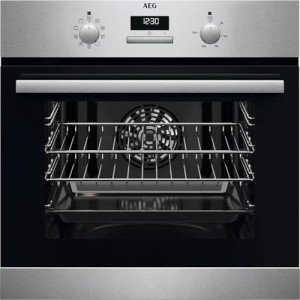
Single Oven And Hob
Add a review FollowOverview
-
Founded Date September 9, 1978
-
Posted Jobs 0
-
Viewed 45
Company Description
The 9 Things Your Parents Taught You About Single Oven
The Ultimate Guide to Single Ovens: Features, Benefits, and FAQs
When it comes to modern-day kitchen home appliances, the single oven stands apart as a versatile and necessary tool for any cooking enthusiast. In today’s busy world, where benefit satisfies culinary craftsmanship, single ovens play a critical role in meal preparation. Understanding the functions, advantages, and kinds of single ovens can simplify the process of picking the ideal device for your kitchen. This thorough guide intends to provide a thorough appearance at single ovens, their specs, and responses to regularly asked concerns.
What is a Single Oven?
A single oven is a kitchen home appliance that features one main cooking compartment. It is created to perform various cooking functions such as baking, roasting, broiling, and more. Unlike double ovens, that include two different cavities, single ovens maximize space efficiency, making them appropriate for smaller sized cooking areas or those who often prepare meals for a few people.
The Anatomy of a Single Oven
In order to appreciate the functionality of a single oven, understanding its crucial elements is necessary:
| Component | Description |
|---|---|
| Cooking Cavity | Main space where food is placed for cooking. |
| Control board | User interface for picking cooking modes and changing temperature. |
| Heating Elements | Metal coils that create heat (often found at the top and bottom). |
| Oven Door | Glass panel that allows visibility into the cooking area. |
| Racks | Removable racks that accommodate numerous meals at different heights. |
Kinds Of Single Ovens
Single ovens come in various types based on their heating approaches and designs. Here are some popular alternatives:
-
Conventional Ovens: Utilize gas or electrical energy for a standard cooking experience. They supply constant heat for baking and roasting.
-
Convection Ovens: Equipped with a fan that flows hot air, resulting in faster cooking times and even heat circulation.
-
Steam Ovens: Use steam to cook food, retaining moisture and nutrients. Perfect for healthier cooking approaches.
-
Wall Ovens: Built into the wall to conserve area; they can boost kitchen visual appeals while providing performance.
-
Microwave Ovens: While not a traditional oven, modern microwave can also bake and roast, using convenience for quick meal preparation.
Functions to Look for in a Single Oven
When acquiring a single oven, think about the following features to ensure you pick an appliance that matches your cooking needs:
-
Capacity: Ensure the oven’s size accommodates your typical cooking volume. Standard capacities normally range from 4.5 to 6 cubic feet.
-
Temperature Range: Look for an oven that provides a broad temperature level range for different cooking methods.
-
Self-Cleaning Options: Self-cleaning modes bypass the requirement for harsh chemicals, making maintenance simpler.
-
Smart Technology: Wi-Fi-enabled models permit remote operation and tracking through smartphone applications.
-
Interior Lighting: Bright, incandescent or LED lighting assists monitor your food without unlocking.
Typical Sizes and Capacities of Single Ovens
| Type | Average Capacity (cubic ft) | Width (inches) | Height (inches) |
|---|---|---|---|
| Standard Conventional | 5.0 – 6.0 | 30 | 28 – 30 |
| Compact/Apartment Size | 3.0 – 4.0 | 24 | 28 – 30 |
| Wall Oven | 4.5 – 5.0 | 24 – 30 | 28 – 30 |
Benefits of Using a Single Oven
Investing in a single oven uses many advantages for both amateur cooks and seasoned chefs alike:
-
Space Efficiency: A single oven inhabits less space than a double oven, making it ideal for smaller sized kitchen areas.
-
Cost-Effective: Generally less expensive compared to double ovens, both in initial purchase and energy consumption.
-
Adaptability: Capable of carrying out various cooking strategies, making it ideal for a range of recipes.
-
Relieve of Use: With a smaller cooking area, heat circulation tends to be more effective, simplifying the cooking procedure.
-
Maintenance: Fewer parts imply less complexity when it comes to cleansing and repairs.
Frequently Asked Questions (FAQs)
What is the average lifespan of a single oven?
A single oven typically lasts between 10 to 15 years, depending on usage, upkeep, and the quality of the home appliance.
How can a single oven save energy?
Single ovens need less power than double ovens, and numerous models are developed with energy effectiveness in mind, minimizing total energy usage.
Can a stove change a standard oven?
Yes, a convection oven can change a standard oven as it offers comparable cooking functions along with faster cooking times.
Are single ovens suitable for large households?
While single ovens can accommodate a decent amount of food, larger families might discover that a double oven or an additional single oven suits their needs more effectively.
How frequently should I clean my single oven?
It is suggested to clean your oven every 3 to six months, depending upon use, to keep hygiene and effectiveness, especially with designs that include self-cleaning options.

Is installation difficult for a single oven?
The majority of single ovens come with uncomplicated installation directions. Nevertheless, consulting an expert is suggested for safe and appropriate setup, particularly for gas ovens.
The single oven remains a cornerstone appliance in kitchen areas all over the world. Its adaptability, effectiveness, and space-saving style make it an appealing option for lots of families. Whether you are a periodic cook or a culinary aficionado, picking the best single oven can significantly boost your cooking experience. With the information shared in this guide, prospective purchasers can make an informed decision, ensuring they pick an oven that best suits their cooking requirements and lifestyle.
